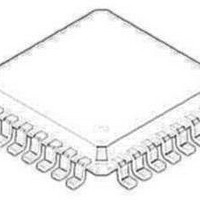NCP5331FTR2G ON Semiconductor, NCP5331FTR2G Datasheet - Page 17

NCP5331FTR2G
Manufacturer Part Number
NCP5331FTR2G
Description
IC CTLR PWM 2PH W/DRVRS 32-LQFP
Manufacturer
ON Semiconductor
Datasheet
1.NCP5331FTR2G.pdf
(36 pages)
Specifications of NCP5331FTR2G
Applications
Controller, AMD Athlon™
Voltage - Input
9 ~ 14 V
Number Of Outputs
2
Voltage - Output
5V
Operating Temperature
0°C ~ 70°C
Mounting Type
Surface Mount
Package / Case
32-LQFP
Mounting Style
SMD/SMT
Lead Free Status / RoHS Status
Lead free / RoHS Compliant
Other names
NCP5331FTR2G
NCP5331FTR2GOSTR
NCP5331FTR2GOSTR
Available stocks
Company
Part Number
Manufacturer
Quantity
Price
Company:
Part Number:
NCP5331FTR2G
Manufacturer:
ON Semiconductor
Quantity:
10 000
Part Number:
NCP5331FTR2G
Manufacturer:
ON/安森美
Quantity:
20 000
Load Step with Fast RC Time Constant (50 ms/div)
Figure 17. Inductive Sensing Waveform During a
Figure 19. Overcurrent Timer Operation
Figure 18. Hiccup Mode Operation
http://onsemi.com
NCP5331
17
current sense signal and the actual inductor current during
a positive step in load current with values of L = 500 nH,
R
signal compensation the value of RSx should be 31 kW. Due
to the faster than ideal RC time constant there is an overshoot
of 50% and the overshoot decays with a 200 ms time
constant. With this compensation the I
must be set more than 50% above the full load current to
avoid triggering hiccup mode during a large output load
step.
Current Limit, Hiccup Mode and Overcurrent Timer
filtered to create an average current signal. The average
current is then compared to a user adjustable voltage at the
I
switching stops, and the COMP pin is discharged until it
decreases to 0.27 V. At this point, the fault latch is reset, the
COMP voltage will begin to rise and a new startup cycle
begins. During startup, the output voltage and load current
will increase until either regulation is achieved or the I
voltage is again exceeded. The converter will continue to
operate in “hiccup mode” until the fault condition is
corrected or the overcurrent timer expires.
a low duty cycle hiccup mode. During hiccup mode the
converter will not switch from the time a fault is detected
until the soft start capacitor (C
COMP Discharge Threshold and then charged back up
above the Channel Start Up Offset. Figure 18 shows the
NCP5331 operating in hiccup mode with the converter
output shorted to GND. Hiccup mode will continue until the
overcurrent timer terminates operation.
converter will operate in hiccup mode. Placing a capacitor
from the C
capacitor sets a longer time. The first hiccup pulse starts the
timer by turning on a current source that charges the
capacitor at the C
to 3 V before the output voltage exceeds the PGD threshold,
then the overcurrent latch is set, COMP is discharged, and
PGD is latched Low. Once set, the overcurrent latch will
hold the converter in this state until the input voltage, either
V
either the output short circuit is removed or the load is
decreased before the overcurrent timer expires, PGD will
transition High after its programmed delay time and the
timer will be reset. The nominal overcurrent time can be
calculated using the following equation.
mode when C
LIM
L
CCL
The waveforms in Figure 17 show a simulation of the
The individual phase currents are summed and low−pass
When an overcurrent fault occurs the converter will enter
The overcurrent timer sets a limit to how long the
Figure 19 shows the overcurrent timer terminating hiccup
t OVC + C OVC @ (OVC THRESH * OVC MIN ) I OVC
= 1.6 mW, RSx = 20 k and CSx = 0.01 mF. For ideal current
pin. If the I
or V
+ C OVC @ (3.0 V * 0.25 V) 5.0 mA
+ C OVC @ 5.5
OVC
CCH
OVC
, is cycled. Conversely, if the timer starts and
LIM
pin to GND sets the length of time − a larger
OVC
charges up to 3.0 V.
voltage is exceeded, the fault latch is set,
pin. If the voltage at the C
10 5
C2
) has discharged below the
LIM
pin threshold
OVC
pin rises
LIM











